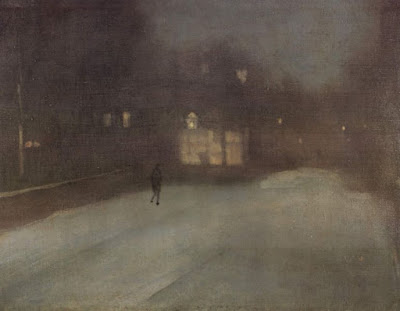Now the outsider is us, alone in the dark, excluded from whatever is going on in that beautiful spot of light.
 |
|
Nocturne in Grey and Gold: Chelsea Snow, 1896, James McNeill Whistler, courtesy Fogg Art Museum
|
Last week my husband was studying a beautiful nocturne by the Taos painter Oscar E. Berninghaus. The dim light is a soft greenish-blue, and he wondered why. Berninghaus didn’t have the advantage of ‘knowing’ what the night sky looks like through color photography. That gave him the liberty to paint what he felt and saw.
The human eye can’t make the adjustment between gloom and brilliance very fast. Because of this, modern photography and lighting have changed how we paint nocturnes, as I wrote here. The change is technological but it also reflects our changing worldview. Nocturnes are about fear and longing as much as they are about design.
 |
|
Nocturne: Blue and Silver: Chelsea, 1871, James McNeill Whistler, courtesy Tate Museum
|
Night-painting evolved into its own discipline in the 19thcentury, about the same time as the first gas lights were invented. This corresponds to the Industrial Revolution and urbanization in Europe and America. Suddenly, people were out of their beds and working and playing until all hours.
James McNeill Whistler, more than anyone else, made the nocturne an important subject for painting. His nocturnes are reticent, diffuse and spare. They resolutely refuse to tell any stories. “I care nothing for the past, present, or future of the black figure, placed there because the black was wanted at that spot,” he said of Nocturne in Grey and Gold: Chelsea Snow.
Whistler is credited for ushering in modern art with these nocturnes. “By using the word ‘nocturne’ I wished to indicate an artistic interest alone, divesting the picture of any outside anecdotal interest which might have been otherwise attached to it. A nocturne is an arrangement of line, form and colour first,” he wrote.
 |
|
Apache Scouts Listening, 1908, Frederic Remington, courtesy National Gallery of Art
|
His peer in nocturne painting was Frederic Remington. He didn’t particularly like Whistler’s arty-farty attitude to painting, or his nocturnes. “Whistler’s talk was light as air and the bottom of a cook stove was like his painting,” he wrote in his diary. Remington, trained as an illustrator, was primarily a storyteller.
He painted his nocturnes late in his short life, as he tried to find a transitional path between illustration and fine painting. The dark, wavering light of night provided a relief from excessive observation. “Cut down and out—do your hardest work outside the picture and let your audience take away something to think about—to imagine,” he wrote in 1903.
 |
|
The End of the Day, c.1904, Frederic Remington, courtesy Frederic Remington Art Museum
|
What was ‘outside the picture’ was often the most important element. Consider Apache Scouts Listening (1908). There’s a fantastic diagonal composition that draws us to the wavering black tree line in the distance. Shadows are cast by unseen trees in the foreground. The crouching scouts listen to some sound we can’t hear, as does the trooper. Even the horses are on edge.
Whistler and Remington had even less photographic color reference than did Berninghaus. That’s why their night skies are so fascinating—they could be any color or texture. The contrast is low, and the unlit night sky is brighter and more varied than we see today.
 |
|
Rooms for Tourists, 1945, Edward Hopper, courtesy Yale University
|
Set their nocturnes against those of later artists like Edward Hopper or contemporary painter Linden Frederick. Their skies are inky blue or black, thrown into utter darkness by the ever-present electric lights.
Likewise, the narrative has been completely set on its head. Now, what’s ‘outside the picture’ is us. We’re alone in the dark, excluded from whatever human activity is going on inside.




